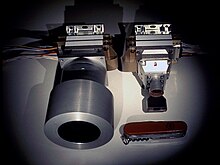
Back أنظمة مالين لعلوم الفضاء Arabic سیستەمی زانستی بۆشایی مالین CKB Malin Space Science Systems German Malin Space Science Systems Spanish Malin Space Science Systems French 말린 우주 센터 Korean Malin Space Science Systems Polish
 | |
| Company type | Privately held company |
|---|---|
| Founded | 1990 |
| Headquarters | San Diego, California |
Key people | Michael C. Malin, CEO |
Malin Space Science Systems (MSSS) is a San Diego, California-based private technology company that designs, develops, and operates instruments and technical equipment to fly on uncrewed spacecraft. MSSS is headed by chief scientist and CEO Michael C. Malin.
Founded in 1990, their first mission was the failed 1993 Mars Observer for which they developed and operated the Mars Observer Camera Ground Data System. After this mission they were selected to provide the main camera for Mars Global Surveyor. They also developed the cameras that were carried on Mars Polar Lander, Mars Climate Orbiter, 2001 Mars Odyssey, Mars Reconnaissance Orbiter and Phoenix lander.

One of the most successful of their instruments to date was the Mars Observer Camera (MOC), on board the Mars Global Surveyor placed into orbit around Mars in September 1997. From that date until November 2006, the MOC took more than 243,000 images of Mars, some at very high resolution. Among the MOCs notable successes was the imaging of the landing sites of the two Mars Exploration Rovers (the discarded heatshield of one of the rovers was located). Even before they landed, images from the MOC were very useful in picking the destinations of the two rovers.
After more than nine years of active duty, the Mars Global Surveyor ceased sending data back to Earth and it is now lost along with all its instruments, including the MOC.
For the Mars Reconnaissance Orbiter, launched on August 12, 2005, MSSS built the Mars Color Imager (MARCI) which takes wide angle, daily global views of Mars and the Context Imager (CTX) which has a six-metre resolution.
The Mars Science Laboratory was launched in 2011 and it carries three MSSS cameras. The MastCam is the main camera on board taking still and motion images of the surroundings. The 'HandLens Imager' is on the instrument arm and provides close up images of martian soil and rocks. Finally the Mars Descent Imager (MARDI) provided high resolution images of the ground during descent.
In December 2004, MSSS was selected to provide three cameras for the Lunar Reconnaissance Orbiter (2008) mission, under contract to Northwestern University. The MSSS developed JunoCam for the Juno Jupiter Mission, which launched in 2011.[1][2]
In July 2014, NASA announced the selection of the Mastcam-Z proposal for the Mars 2020 rover mission, provided by MSSS. It is an improved zoom version of the original MastCam.[3]

- ^ Daisy DobrijevicContributions from Clara Moskowitz (April 3, 2023). "Jupiter missions: Past, present and future". Space.com. Retrieved May 7, 2024.
- ^ "Tell NASA which points of Jupiter you want Juno to spy!". The Economic Times. July 5, 2016. ISSN 0013-0389. Retrieved May 7, 2024.
- ^ "NASA Selects MSSS to Provide Science Camera FOR 2020 Mars Rover Mission". Retrieved September 10, 2015.